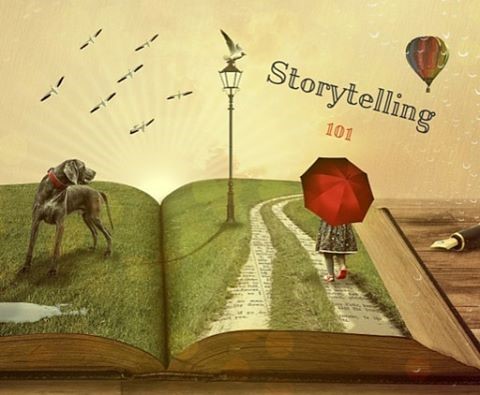“Storytelling” is the art of telling a story by using a language essentially based on emotions. It is a technique frequently used in marketing in which the story-teller tries to connect with potential customers or with the public in general by creating an emotional link.

The Historian, by E. Irving Couse (in.wikipedia) [Public domain], via Wikimedia Commons
The main aim of storytelling is to achieve a greater empathy with our customers, to engage them with your product/service and basically sell it.
Annette Simons, author of one of the most famous books about the art of storytelling “The Story Factor: Inspiration, Influence, and Persuasion through the Art of Storytelling”, affirms that “people are 80% emotional and 20% rational. The difference between emotion and reason is that emotion leads to action, whereas reason leads to conclusion”.
Some of the advantages of the storytelling technique are:
• To build confidence, mainly when we tell a story giving unknown details from a different perspective.
• The message that we want to send out is easily remembered, since it is summarised in a story with a close sequence of facts.
• Stories are easy to transmit, since the story can be easily remembered.
• Stories create an emotional connection with our potential customers.
• Stories can be used as a tool by entrepeneurs to evaluate business ideas.
In the following Youtube videos you can see an interesting introduction to storytelling.

[CC-BY], https://goo.gl/images/ku8qB3
How to put storytelling into practice?
Imagine a story as if it was an experience we want to shape in order to share it. Its plot must be convincing and interesting so that any person can understand the proposal.
It is important to use some techniques such as how the product is created, the motivations, the inspiration or the adversities found in its creation, the main ideas that lead to the creation of your product/service, etc.
It is also important to remember that
“It’s not just about the story but also how the story is told that matters”.
You can create the story from the customer´s perspective by taking as a reference an average customer and bring the value of your product to the customer´s attention. You can also create it from your own perspective by showing what your product may offer to your customers.

[CC-BY 2.0], Flickr, https://flic.kr/p/GbWoZV
When preparing your storytelling, the following steps must be taken into account:
Establish the goal/s that you want to reach with your story and try to make them measurable.
Analyze the differential value of your product.
It is also important to analyze your potential customers´different profiles by identifying their expectations and needs.
Create the plot of your story on a possible problem that must be solved: develop an attractive plan and a series of situations in which the customer can be involved and finally introduce an ending with your proposal.
Make a decision about the type of story that you are going to use: personal, fantastic, etc.
Develop the story from the simplest and most global ideas to the smaller and more specific details.
Foster participation and dialogue and make sure that your potential customers understand the story.
Use multimedia resources available.
Prepare a communication plan once you have created the story.
Finally, establish a series of objective indicators to measure, when possible, the effects of your communication strategy.
There are many real cases about products that became known through the storytelling technique.
Applications such as Mi nube (http://www.minube.com) an application that spreads thousands of tourist destinations, have based their success on their users´ personal stories and experiences after having visited some of the destinations. This is done under the approach of the typical Web 2.0. services.
In the following videos you can see two good examples of storytelling: Nike and Johnnie Walker whisky.
Another excellent example of success by an initiative thanks to the use of storytelling is the worldwide known TED talks (https://www.ted.com/).
It is a series of conferences held by numerous experts on a great variety of subjects. The storytelling technique is widely used in these conferences.
A good example of storytelling can be seen in the following conference held by Andrew Stanton, film director, scriptwriter and producer of films such as a Bug´s Life, Finding Nemo, Wall-E and Toy Story.
The clues to a great story
Filmmaker Andrew Stanton ("Toy Story," "WALL-E") shares what he knows about storytelling -- starting at the end and working back to the beginning.
The clues to a great story. https://blog.ted.com/how-to-tell-a-great-story-visualized/
Storytelling topic in TED talks
https://www.ted.com/topics/storytelling
To finish with, we are going to see the six types of stories that Annette Simons suggests on her website (http://annettesimmons.com/the-six-kinds-of-stories/)
Who I Am stories
What qualities earn you the right to influence this person? Tell of a time/place/event that provides evidence that you have these qualities. Reveal who you are, as a person. Do you have kids? What were you like as a kid? What did your parents teach you? What did you learn in your first job? Get personal. People need to know who you are before they can trust you.
Why I’m here stories
If you wish to influence, regardless of your objective, you are asking for a person’s time, money, or resources… people certainly need to know what’s in it for them. However, people don’t really relax and listen until they are satisfied that they know what’s in it for YOU.
If your audience understands that you want their cooperation solely to meet your needs, they immediately discredit your “facts” as biased. Keep it short, but explain the big picture about why you are investing your time with them on this matter.
“Vision” stories
An exciting future story reframes present difficulties as “worth it.” Big projects and new challenges can be difficult and frustrating particularly for people who weren’t "there" on the decision-making process. Without a vision, meaningless frustrations suck the life energy out of a group. With an engaging vision huge obstacles shrink to small irritants on the path to a worthwhile goal. (Note: Vision stories that promise more than they deliver do more damage than good. So be careful.)
“Values in Action” stories
Values are subjective. Integrity may mean doing what your boss tells you to do, or saying "no" even if it costs your job. This is why the only way to communicate a value is by example (best), or with a story (2nd best). The word “integrity” is abstract so that people often pretend they have communicated. Nothing is communicated if no one knows what you mean when you say “integrity.” If you want to encourage or teach a value, a story provides a “demonstration” by showing in the theatre of your listener’s mind what that value means.
“Teaching” stories
Certain lessons are best learned from experience— but much of the time you can’t just manufacture an experience for someone. When the experience of failure is too expensive or disastrous to endure – story can simulate an experience, so that a learner can vicariously live the moments before, during, and after an event in the theater of his or her own mind.
Other lessons, like patience, are rarely learned once and for all. We have to learn these lessons again and again on a regular basis. And posters on the wall don’t cut it. If someone is being impatient, telling them to “be more patient” is not going to get good results. Better to tell a story of patience in a pace and with timing that demonstrates its rewards. Chances are a story will work better than advice. Discipline, humility, respect, …these skills need role models and stories to help learners develop the habits you seek.
“I Know what you’re thinking” stories
People like to stay safe. Many times they have already made up their mind, with specific objections to the ideas you bring. They stop you before your presentation and tell you, “We talked about this at dinner last night and we don’t like it,” but they might be thinking it. It doesn’t matter that they made their decision on a distorted version of the facts. They may just like the idea that today’s meeting will be short and they go home early because veryone has already dismissed your idea.
It is a trust-building surprise for you to give voice to their secret suspicions in a story that first validates and then dispels these objections without sounding defensive. It gets their attention that you know more than they thought you did…and earns you the benefit of the doubt that you may know other things they don’t know.
Websites of interest













